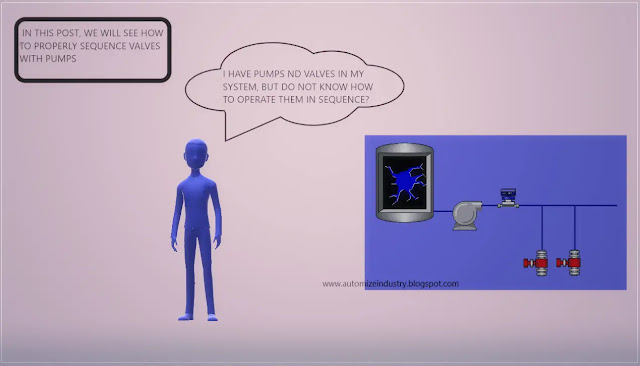Valve Sequencing
28 Sept, 2022.
In this
post, we will see the standard valve sequencing logic used in almost every
control systems.
Valves always comes in operation with pumps. When you are operating valves, it is necessary to apply some means to prevent reverse flow of liquid through the pump when it turns off. Also, it is required to ensure that the pump does not run dry or the line gets pressurized due to any abnormal operation of valves. So, it is necessary to maintain or design proper sequencing of valves in conjunction with pumps; so that the entire line works properly. In this post, we will see the standard valve sequencing logic that needs to be followed in industrial automation for proper control.
Problems with pumps:
Most pumps are equipped with some sort of valve arrangement attached to their suction and discharge lines. This is used to prevent backflow and hydraulic pressure surges. Sometimes, a valve may fail to operate correctly. One of the most common failures is that the valve would stick open when commanded to close. This is generally caused by debris catching in the valve body and not allowing valve to seat. The consequences are dangerous. The pumped liquid will begin to run backward through the pump and cause the pump impeller to spin backward. The motor, pump and drive shaft may be subjected to very high rotational speeds at this time.
Since the motor is spinning in a reverse direction, applying power to the motor could cause severe torque and current surges which could damage the pump, motor or drive. The flow output is also affected. If the valve is turned off or on along with the pump, then the line will be pressurized to a very high extent and it can create abrupt sounds which means it can be damaged if operated for prolonged time. So, it is required to properly control the sequencing logic of valves and pumps and maintain a proper delay between them.
Valve Sequencing:
1. First of all, you will require open
and close feedbacks of the valve (suction and discharge). This is the most
important step; because it shows the exact status of valves. Then, if you are
using a drive, then the run feedback will be required from VFD. If you are not
using a drive, then the run feedback will be required from the contactor or
overload relay.
2. Now, before starting the pump, it
must be ensured that both the suction and discharge valves are closed. If it is
not closed, then generate an alarm from PLC which indicates that the valves are
not closed and needs attention. Check
the valves and troubleshoot it. Once you receive the close feedbacks, then you
are ready to operate the pump. Also, during off condition, you must not receive
open feedbacks. If you are receiving it, then generate an alarm and check the
system first. Once you are ready with both the types of feedbacks, it means the
system can be started now.
3. Start the system. First, give
commands to both the valves. The valve will open and you will get open
feedbacks from them. If you do not receive the open feedbacks after a certain
period of time, then generate an alarm and trip the system and shutdown the
valves. Pump will not be started as long as you receive the open feedbacks. Troubleshoot
why you did not receive the open feedbacks. For that, just manually operate the
valves. Once you receive the open feedbacks, then you are ready to start the
system once again.
4. Restart the system once again. Open the valves and when you receive open
feedbacks, then check whether the close feedback has gone off or not. If you
are still receiving the close feedback, then trip the system by generating an
alarm and check why the close feedback did not go off. Once you have solved the
issue, then the system is ready to start again.
5. Repeat the fourth step. If you
receive open feedbacks and do not receive the close feedbacks, then after a
certain period of time, start the pump. If the pump is started and you do not
receive it’s feedback, then stop the system. Check the feedback of pump. Once
you have verified the feedback, then again restart the sequence from the steps
discussed earlier.
6. Now, if you are stopping or
tripping the system by any chance after the pump has started, then first turn
off the pump. Once it is ensured that the run feedback of pump has gone off,
turn off the valves after a certain delay. If the valves have turned off and
you receive close feedback and do not receive the open feedback, it means that
system has successfully stopped. If you do not receive any of the feedbacks,
then generate an alarm through which the operator can troubleshoot the system.
I have covered
the general principles used in sequencing valve systems. I have also not attempted to
cover every theory of these types deeply; you can learn it easily once you get
familiar with them. I have just given you an insight of these types of
controls. Once you are done with these, I am hopeful you will be easily able to
understand any valve system properly. Learn the basics and explore a new type
of study in this type of automation. It will take some practice and as you go
on studying the valve system, you will become more familiar with it.
Thank you guys; I hope you enjoyed reading the
practices normally used for this type of study in industrial automation.




Comments
Post a Comment
If you have any queries, please let me know